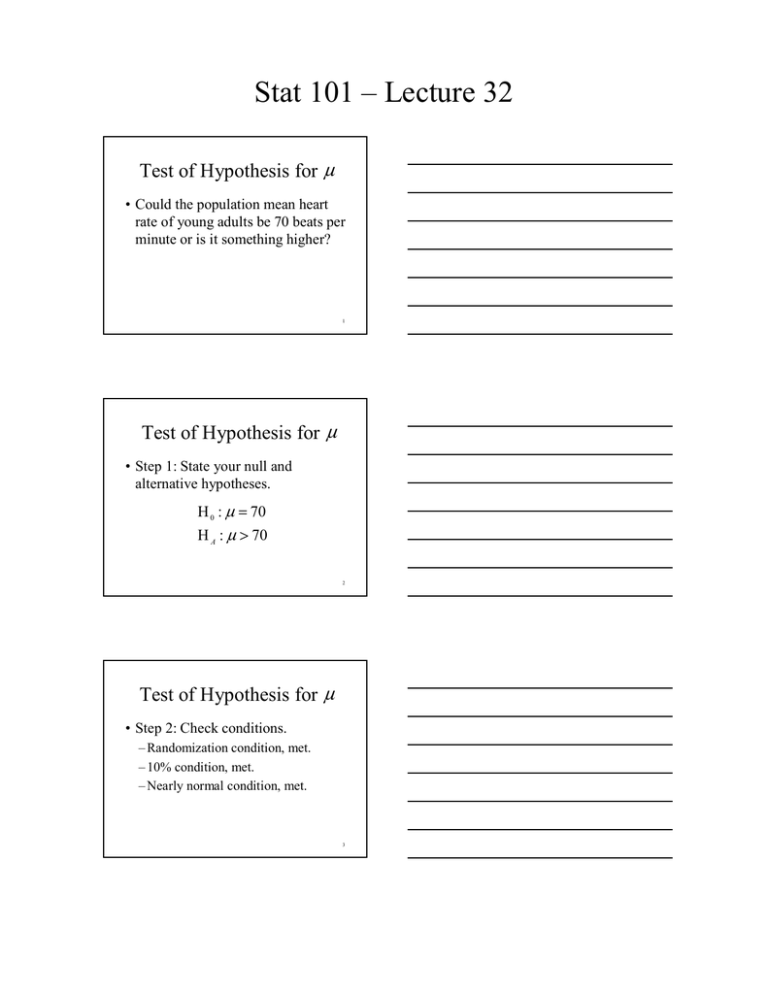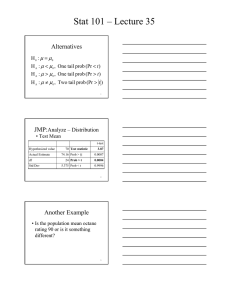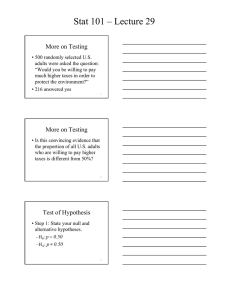Stat 101 – Lecture 32 Test of Hypothesis for µ
advertisement

Stat 101 – Lecture 32 Test of Hypothesis for µ • Could the population mean heart rate of young adults be 70 beats per minute or is it something higher? 1 Test of Hypothesis for µ • Step 1: State your null and alternative hypotheses. H 0 : µ = 70 H A : µ > 70 2 Test of Hypothesis for µ • Step 2: Check conditions. – Randomization condition, met. – 10% condition, met. – Nearly normal condition, met. 3 Stat 101 – Lecture 32 Test of Hypothesis for µ • Step 3: Calculate the test statistic and convert to a P-value. y − µ0 t= SE( y ) s SE( y ) = n 4 Summary of Data • n = 25 • y = 74.16 beats • s = 5.375 beats • SE ( y ) = s = 1.075 beats n 5 Value of Test Statistic y − µ 0 74.16 − 70 = SE ( y ) 1.075 t = 3.87 t= Use Table T to find the P-value. 6 Stat 101 – Lecture 32 Table T One tail probability 0.10 0.05 0.025 0.01 0.005 P-value df 1 2 3 4 M 24 2.064 2.492 2.797 3.87 The P-value is less than 0.005. 7 Test of Hypothesis for µ • Step 4: Use the P-value to reach a decision. • The P-value is very small, therefore we should reject the null hypothesis. 8 Test of Hypothesis for µ • Step 5: State your conclusion within the context of the problem. • The mean heart rate of all young adults is more than 70 beats per minute. 9 Stat 101 – Lecture 32 Alternatives H 0 : µ = µ0 H A : µ < µ0 , P - value = Pr < t H A : µ > µ0 , P - value = Pr > t H A : µ ≠ µ0 , P - value = Pr > t 10 JMP:Analyze – Distribution • Test Mean t-test Hypothesized value Actual Estimate df Std Dev 70 Test statistic 74.16 Prob > |t| 3.87 0.0007 24 Prob > t 0.0004 5.375 Prob < t 0.9996 11 Another Example • Is the population mean octane rating 90 or is it something different? 12 Stat 101 – Lecture 32 Test of Hypothesis for µ • Step 1: State your null and alternative hypotheses. H 0 : µ = 90 H A : µ ≠ 90 13 Test of Hypothesis for µ • Step 2: Check conditions. – Randomization condition, met. – 10% condition, met. – Nearly normal condition, met. 14 Normal Quantile Plot 3 .99 2 .95 .90 1 .75 0 .50 .25 -1 .10 .05 -2 .01 -3 6 4 Count 8 2 87 88 89 90 91 92 93 Octane Rating 94 95 15 Stat 101 – Lecture 32 Test of Hypothesis for µ • Step 3: Calculate the test statistic and convert to a P-value. y − µ0 t= SE( y ) s SE( y ) = n 16 Summary of Data • n = 40 • y = 90.9475 • s = 1.530 • SE ( y ) = s = 0.2419 n 17 Value of Test Statistic y − µ 0 90.9475 − 90 = SE ( y ) 0.2419 t = 3.92 t= Use Table T to find the P-value. 18 Stat 101 – Lecture 32 Table T Two tail probability 0.20 0.10 0.05 0.02 0.01 2.021 2.423 2.704 P-value df 1 2 3 4 M 39 40 3.92 The P-value is less than 0.01. 19 Test of Hypothesis for µ • Step 4: Use the P-value to reach a decision. • The P-value is very small, therefore we should reject the null hypothesis. 20 Test of Hypothesis for µ • Step 5: State your conclusion within the context of the problem. • The population mean octane rating is not 90 but something different. 21 Stat 101 – Lecture 32 Confidence Interval for µ y − tn*−1SE ( y ) to y + tn*−1SE ( y ) 90.9475 ± 2.021(0.2419 ) 90.95 − 0.49 to 90.95 + 0.49 90.46 to 91.44 22 Interpretation • We are 95% confident that the population mean octane rating is between 90.46 and 91.44 23 Interpretation • This confidence interval agrees with the test of hypothesis. • 90 is not in the interval and so must be rejected as a value for the population mean. 24




